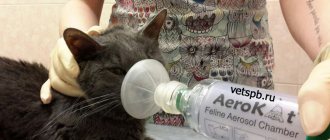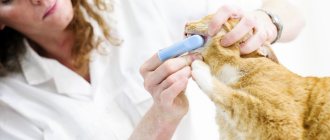Body temperature is one of the main indicators that indirectly indicates the health of a cat. Its significant deviations from the norm require urgent veterinary attention. From the article you will learn what temperature is considered normal depending on the age of the pet, what diseases lead to its increase and decrease, and how to help your four-legged pet at home.
Content
- Normal body temperature in cats
- How to correctly measure a cat's temperature Contact measurement of a cat's temperature step by step
- The main reasons for the rise in temperature
- First aid for hyperthermia
Reasons for abnormal body temperature in cats
Body temperature in cats can be not only normal, but also increased (hyperthermia) or decreased (hypothermia). Any of the deviations, up or down, may indicate a serious pathology in the body of a four-legged pet.
Reduced temperature value
Several reasons can lead to a decrease in temperature in representatives of the cat family, the main one of which is hypothermia. It is favored by both cold and wet weather.
Hypothermia in a cat leads to a drop in its temperature
When a cat's fur is wet, there will be no air gap between the hairs; in this state, the cat becomes “naked” and is especially susceptible to hypothermia, a decrease in body temperature.
Such pathologies are especially typical for small kittens and older animals. Their thermoregulation works intermittently and cannot maintain stable body temperature. Because of this, you should not let older cats outside in the spring and fall.
In addition, the following reasons lead to hypothermia:
- Viral infections that reduce cat immunity.
- Lack of appetite, weight loss.
- Malaise, weakening of the animal’s body.
- Malignant neoplasms.
- Various injuries.
- Consequences of the administered anesthesia.
- Kidney disease, which occurs more often in older animals.
- Disruption of metabolic processes in the body due to a lack of useful components and vitamins.
- Consequences of poisoning, dehydration.
- Enteritis is a group of inflammatory diseases of the small intestine. This disease is observed mainly in small kittens, but it is also dangerous for adult kittens kept in poor conditions, undernourished, and stressed. The virus of this disease, which comes out of the animal's body in feces, can be dangerous to surrounding cats.
- Heart diseases.
- Diseases of the nervous system, in which the behavior of pets changes greatly; they become indifferent to games and entertainment.
- Severe internal or external bleeding.
External bleeding can be noticed visually, internal bleeding is determined by the color of the stool or urine.
The following signs indicate a low temperature in a cat:
- lethargy of the cat;
- searching for a warm place;
- slow breathing in your pet;
- heart rhythm disturbances;
- raised wool;
- trembling throughout the pet's body.
Elevated temperatures
An increase in body temperature in four-legged friends can be caused by both external and internal stimuli. This mainly occurs due to the following reasons:
- Infectious diseases. These include diseases called plague, calcivirosis, rhinotracheitis, coronavirus. The cat's body responds to pathogen invasion by increasing body temperature. This causes the introduced microorganisms to die faster.
- Inflammatory diseases. In such cases, pathogenic bacteria enter the cat's body during the slow healing of wounds and sutures after injuries, operations, or when they were carelessly treated.
- Overheating. A disturbance in heat transfer occurs when the animal is in hot, stuffy rooms, cars, or under the bright rays of the sun. Overheating mainly affects older cats and kittens, as well as small kittens.
In a closed car in the sun, the temperature rises to very high levels, the animal may overheat
- Stressful situations. Violation of thermoregulation is caused by acute circumstances that arise during trips in various types of transport, visits to veterinary clinics, and when changing place of residence.
- After vaccinations and sterilizations. The result of such procedures can be temperature jumps of approximately 1 degree. In one case, the jump is due to the reaction of the cat's body to surgery. In another case, it protects the animal’s body from the action of viruses that enter it with the injected vaccine. The cat's temperature remains above normal for approximately 3 days; if it does not subside, you should show the cat to a veterinarian.
In kittens, normal body temperature is slightly different from that of adult animals. The fact is that babies have greater mobility and energy. For the normal functioning of their body, large amounts of energy are required. Indicators characterizing normal temperature in kittens are in the range of 38.5 – 39.5 degrees, and this is slightly higher than in adult felines.
Newborn kittens have even higher temperature values, ranging from 40–40.5 °C. They are considered normal, and nothing should be done in this case. If you have any suspicions, there is no need to constantly measure the temperature; you need to wait a little, since the kittens have not yet gotten over the shock of the birth process. If necessary, a kitten’s temperature can be measured no earlier than it is 3 weeks old.
Symptoms indicating a rise in temperature and a possible serious illness are as follows:
- weaknesses of the cat's body;
- lack of appetite;
- shock in an animal;
- difficulty breathing;
- shortness of breath, wheezing;
- reddened eyes;
- heart rhythm disturbances;
- vomiting, diarrhea;
- dehydration of the body;
- body trembling, chills;
- internal bleeding;
- yellow coating in the mouth.
If the animal has these signs, it will need specialist advice. If you don't immediately help your pet, it can end in death.
A sick animal does not have enough strength to thoroughly lick its fur. His fur will look matted and dull.
Normal body temperature in cats
In adult male cats, the normal temperature is in the range of 37.7-39.4°C (average 38.6°C). This indicator may vary depending on age and some physiological characteristics, but does not depend on the breed - hairless and long-haired cats normally have the same temperature.
Table - Temperature of cats depending on age and physiological conditions.
| Healthy kittens up to three weeks of age | 35.6-37.8°C |
| Kittens over 3 weeks old | 38.2-39.8°C |
| Elderly cats and female cats (over 10 years old) | 37.2-38.9°C |
| Pregnant cats | 38.2-39.8°C |
| Females in heat | 38.2-39.8°C |
In nursing cats, the temperature does not differ from normal healthy animals of their age, and any increase in temperature may indicate mastitis or postpartum complications.
Reasons for the drop in temperature
Children and older cats are most often susceptible to hypothermia. Symptoms of such a process are noticeable trembling of the whole body, apathy and complete indifference to games, slow breathing and heartbeat, dilated pupils, pale visible mucous membranes, fluffy fur, the pet’s attempt not to freeze under a blanket or radiator by curling up and covering its nose with its tail or paws.
The reason for a decreased body heat index may be:
- hypothermia;
- infectious and viral diseases that have a destructive effect on the animal’s immune system;
- lack of appetite, loss of weight and muscle mass;
- an unwell, weakened body after suffering an illness or injury;
- malignant tumors;
- kidney failure and disease;
- disruption of the metabolic process due to a high lack of beneficial microelements and vitamins;
- poisoning and dehydration of 1/10 of the body;
- excessive blood loss, including internal bleeding;
- diseases of the heart, intestinal epithelium in kittens, central nervous system.
Note! A decrease in temperature to 35-32 °C is a mild form of hypothermia, to 32-28 °C is moderate, and less than 28 °C is deep.
Wrapping yourself in a blanket or a warm terry towel, on top of which a heating pad with water at 39 °C is placed in the back area, and frequent warm drinks (milk or fatty broth) will help increase the indicator to the normal level. If there is wet wool, dry it with warm air from a hair dryer. When the temperature rises by a couple of tenths of a degree, it is recommended to feed your pet a small amount of warm food. Prolonged hypothermia can lead to pneumonia, kidney disease, or inflammation of the surface of the brain.
Important! The inability to raise the temperature on your own to the normal limit or reaching 36 ° C and its further decrease is a reason for an urgent trip to the veterinary clinic. Professional diagnostics will help establish an accurate diagnosis and prescribe effective treatment.
Knowing what the normal temperature is for cats will help identify deviations from generally accepted standards. A change in the pet’s usual behavior and the manifestation of characteristic symptoms will indicate the need for preventive measurement of the thermal index, the timeliness of which will allow the necessary assistance to be provided.
How to measure a cat's temperature correctly
You can measure a cat's temperature at home with any thermometer designed for humans - contact (mercury, electronic) or non-contact infrared. The most accurate readings can be obtained using a mercury thermometer, but this method is suitable for animals that are calm about therapeutic and diagnostic manipulations. Readings taken with an infrared thermometer are the least accurate, but non-contact readings are sometimes the only possible way to measure temperature in nervous, restless pets. When using electronic devices, you must carefully study the instructions and strictly follow the instructions.
You can measure your cat's temperature yourself at home.
Contact temperature measurement of a cat step by step
- Shake the mercury thermometer so that the mercury column drops to the lower value, the electronic one just needs to be turned on. Lubricate the tip with Vaseline.
- Temperature is measured rectally with the cat lying or standing. To ensure immobility, the cat is secured by the scruff of the neck. To do this, it is better to invite an assistant who will hold the pet. If the animal resists, it is wrapped in a towel, a light blanket, or secured with a special bag.
- Raise the tail and carefully insert the tip into the anus to a depth of about a centimeter (the anus in cats is located above the vulva, just under the tail). During measurement, you should prevent the cat from trying to sit down - this could cause the tip to break off.
- The mercury thermometer must be held for at least 3 minutes, the electronic thermometer must be held until the sound signal.
- Take out the thermometer and record the readings.
After use, the tip of the thermometer should be washed and thoroughly wiped with alcohol to destroy pathogenic flora. If the tip breaks off and remains in the cat’s body, you should immediately contact a veterinarian. Attempting to remove it yourself can lead to severe intestinal injuries.
To measure temperature with an infrared thermometer, the device is brought to the ear from the inside, without touching it, and wait for a sound signal. During measurement, the cat's head must be fixed.
Measuring the cat's temperature with an infrared thermometer
Mr. Cat Explains: Pet First Aid
In cases where thermometry shows deviations from the norm, you need to take your pet to a doctor. He will be able to determine the cause of the temperature change and prescribe the necessary treatment.
If it is not possible to go to the clinic immediately, then the owner must provide first aid to his pet.
When a cat has a low body temperature, the following measures should be taken:
- the animal has a fever, it is freezing, so it needs to be warmed by wrapping it in a warm soft cloth (for example, a blanket);
- close windows and doors to prevent drafts and cold air from entering;
- you can put the cat on an electric one or place a regular rubber heating pad next to it (if you don’t have such means at home, you can use bottles of hot water, you just need to regulate the temperature to prevent burns);
- to prevent dehydration of the body, the cat should be regularly given something to drink; water or milk should be warm; if the animal refuses, then it is necessary to pour the liquid into the mouth with a pipette or a special syringe (you can take a regular, two-cc one, without a needle).
Once in a warm place, the cat will immediately fall into a sleep, after which he will feel better. However, it is still necessary to show the animal to a veterinarian.
If hyperthermia is detected during the measurement, the following set of measures should be taken:
- moisten the animal’s fur with water or wrap it in a damp towel;
- give cool liquid to drink;
- Apply several ice cubes to your neck or inner thighs (wrap the ice in a cloth or plastic bag).
These measures will help alleviate the cat’s fever a little, reducing the temperature by a few tenths of a degree.
Under no circumstances should you lower your animal’s temperature with antipyretic drugs, antibiotics, or other medications produced for humans.
The dosages of active ingredients in such products are specially calculated and may be too high for a cat. In addition, without knowing the true cause of hyperthermia, you should not give medications at all, choosing them yourself, without a prescription from a veterinarian. In animals, drugs can cause serious intoxication, the likely outcome of which is death.
If the temperature remains high or continues to rise, the animal should be taken to the doctor immediately. It should be understood that an increase in indicators to critical values can lead to death.
The owner should know in what cases thermometry should be carried out and how to help his pet. Timely measures taken in case of deviations in physiological indicators can save the cat’s health and life.
Possible causes of hypo- and hyperthermia
Hyperthermia is an increase in body temperature, and hypothermia is a decrease in body temperature. Temperature changes can occur under the influence of cooling or heating of the environment, metabolic reactions in the cat's body. The nervous system is responsible for maintaining normal temperature balance (thermoregulation); central and autonomic disorders can lead to temperature changes.
The main reasons for the rise in temperature
- infectious and inflammatory diseases - panleukopenia, calicivirosis, rhinotracheitis, mastitis, endometritis, cholangitis, pancreatitis, menignitis, abscess and others;
- reaction to vaccination;
- surgery;
- acute poisoning;
- heat damage due to prolonged exposure to the sun, especially in a locked room or car;
- hyperfunction of the thyroid gland (thyrotoxicosis);
- malignant tumor.
Reasons for the decrease in temperature
- hypothermia;
- anemia due to helminth infestation or internal bleeding;
- severe exhaustion;
- thyroid insufficiency (hypothyroidism);
- terminal stage of the disease - cancer, chronic renal failure;
- suffered a serious illness - the temperature may be reduced for several weeks during the recovery period.
With a traumatic brain injury, stroke, or severe stress, body temperature can either increase or decrease.
A cat's temperature is measured rectally using a mercury or electronic thermometer.
Normal indicators in kittens
In kittens, temperature readings can vary quite a lot, since not all systems and organs are still functioning at full capacity, and the process of thermoregulation is not entirely debugged. At an early age, all the work of the central nervous system is aimed at growth and development, so their metabolic processes occur very quickly.
In general, the same indicators as in adults (38-39.5 degrees) are considered normal, but there are quite a few exceptions to this rule. When a kitten is still very tiny, a decrease in temperature is much more dangerous for its body than a strong increase.
In addition, his immune system is also in the process of formation. He constantly encounters various microorganisms, to which protective mechanisms are developed. An increase in body temperature may indicate that the body has encountered another infectious agent and is forming immunity to it.
Kittens and adult animals also have differences in the functioning of their mucous membranes, so you should not focus on the dryness or wetness of the nose when determining the condition of a small animal.
A kitten's temperature undergoes major changes throughout the day. For example, after a period of high activity or a heavy meal, it may seriously exceed normal values, and then return to normal within a short time.
Unlike adults, it affects the body temperature of a small animal and the state of the environment. His thermoregulation mechanism has not yet been established, and if the baby is in conditions of a sufficiently low temperature and is freezing, then his body can heat up to 40 degrees or more.
The temperature is finally established and ceases to vary greatly at the age of about 6 months, although this figure greatly depends on the individual characteristics and breed.
Most cats are considered mature at 12-15 months of age. In some breeds, adulthood occurs much later, around 3-4 years.
For what symptoms should you measure your temperature?
An elevated temperature may be indicated by hot ears, nose, and paw pads at rest, accompanied by dryness of the nose and redness of these areas. Its decrease, on the contrary, is accompanied by their unnatural coldness and pallor. If such changes occur, the temperature should be measured. Other indications for this procedure:
- copious and (or) purulent discharge from the mouth, eyes, ears, nose, anus, vagina, penis, sneezing, coughing are signs of infection;
- nausea, vomiting, diarrhea - symptoms of inflammation of the digestive system, helminth infestation, traumatic brain injury, overheating;
- pallor of the skin and mucous membranes – observed in anemia;
- convulsions, tremors (trembling of the paws, head, entire body), loss of consciousness - observed with a strong increase or decrease in temperature for various reasons, neurological or thermal damage;
- loss of appetite, weight loss, lethargy, apathy or, on the contrary, anxiety, agitation - can accompany most diseases.
Sometimes a veterinarian may prescribe daily temperature measurements to monitor the dynamics of the disease and monitor the effectiveness of treatment.
How to tell if a cat has a fever
Today, the only accurate method to understand that a cat has a temperature is to use a thermometer. However, there are several signs that indicate your cat is not feeling well.
- Lethargic or inappropriate behavior
- Loss of appetite
- Increased thirst
- Rapid or, conversely, infrequent breathing
It is impossible to accurately determine elevated body temperature “by the nose”! Of course, a healthy cat's nose should be cold and damp, but only an active cat under ideal conditions. The humidity of the nose and its local temperature are influenced by the pet's activity, nervous excitement, desire to drink and eat, and environmental climate.
What to do at high and low temperatures
A temporary slight increase in temperature after vaccination or surgery (including castration of a cat, sterilization of a cat) is a normal reaction of the body and does not require veterinary care. Overheating and mild hypothermia can be dealt with independently. You should contact your veterinarian in the following cases:
- with changes in temperature accompanied by signs of any disease;
- with a sharp increase in temperature after surgery;
- with unexplained temperature fluctuations or a stable, prolonged change in temperature without other signs of illness.
Heatstroke, a decrease in body temperature below 32.2°C and an increase above 40°C require emergency contact with a veterinarian. Animals in this condition require intensive therapy, pain relief with narcotic analgesics - normalization of temperature, even with moderate hypothermia, can be accompanied by painful shock.
A temporary slight increase in temperature after vaccination does not require veterinary treatment. help
Is it necessary to bring down the high temperature?
If the values are critical, before the veterinarian arrives (when calling at home), you can try to reduce the temperature:
- give plenty of fluids;
- moisten the wool with cool water;
- Place a damp cloth or some ice in the groin folds.
You should not give your cat antipyretic drugs intended for humans (Aspirin, etc.). They can aggravate the animal's condition and lead to its death. The pet should be treated in accordance with the recommendations of a specialist.
First aid for a cat at home
Normalizing body temperature does not cure the underlying disease, but improves the pet’s general condition and prevents the development of complications. A critical increase in temperature changes leads to damage to vital organs and systems and disruption of their functions. At home, before visiting a doctor, you can only use physical methods to lower or raise the temperature - cooling measures and warming, as appropriate.
It is unacceptable to lower your cat's temperature with medications on your own.
Antipyretic drugs, which are practically safe for humans, can lead to intoxication of the cat’s body, so their use is possible only as prescribed by a veterinarian. It is strictly forbidden to treat a cat with antipyretics and painkillers of the anilide group (paracetamol, Panadol, Tylenol, Efferalgan, acetaminophen and others) - they lead to severe hematopoietic disorders and the death of the animal.
First aid for hyperthermia
Cooling measures are required for cats with temperatures above 39.4-40°C; at lower temperatures they can lead to hypothermia. In case of heat injury, one of the most effective methods of cooling is wetting the fur and then placing the animal under a powerful fan. You can alleviate the condition at elevated temperatures with ice packs - they are applied to the inner surface of the thighs and neck. This method is convenient for emergency transportation of a pet to a veterinarian. If there is no constipation, diarrhea, or acute abdominal pain, cold water enemas will help reduce the temperature. Another way to eliminate hyperthermia is to wet the paw pads with alcohol.
Ice covering the entire body and general cold baths are not recommended. They cause a narrowing of peripheral vessels, which contributes to the flow of “overheated” blood to the internal organs and their further damage.
If the temperature drop is insignificant, it is enough to wrap the cat in a blanket
First aid for hypothermia
For a cat with a slight (up to 32.2°C) decrease in temperature without signs of exhaustion, it is enough to wrap it in a blanket, after drying the wet fur with a towel or hairdryer. If the animal is exhausted or the previous method is ineffective, warm air is blown under the blanket with a hairdryer, and it is better to wrap the animal’s head as well. With a more pronounced decrease in temperature, the animal is covered with bottles of warm water and taken to the clinic.
If a cat that has been exposed to the cold for a long time does not show signs of life, it should be examined by a veterinarian - during an amateurish examination, a living pet in this state is often mistaken for dead. Cats with severe hypothermia should be transported to the clinic carefully, protecting them from shocks - even the slightest mechanical impact can lead to cardiac arrest and death.
In kittens under 3 weeks of age growing up without a mother, their body temperature drops even when kept in a relatively warm room - their body is able to maintain a temperature only 5-7°C above the environment. The nest of such babies should be kept warm at least 29-32°C. The space inside the box can be heated with lamps, hot water bottles wrapped in a towel.
Learning to measure a cat’s temperature and knowing what its changes may be associated with is important for every owner who loves their pet. This will help the doctor quickly determine the diagnosis, adjust treatment in time and maintain the health of the animal.
How to provide first aid to a pet with deviations in body temperature
In any situations involving deviations of your pet's temperature from normal values, you should consult a veterinarian. But the owner needs to be able to provide the cat with the necessary help himself. This can be done at home using folk remedies or drugs purchased at the pharmacy.
At high temperature (hyperthermia)
Before you do anything, you need to correctly measure your pet's body temperature. If it has risen slightly, then you should not knock it down. Such a slight increase indicates that the body’s protective functions have come into play. If the measurement result is lower than or equal to 39.3 degrees, you should simply watch the cat. After an hour, you need to measure the temperature again.
A cat is considered to have a fever if its temperature is 39.4 degrees or higher.
If there is a significant change in temperature (about 40.5o), it is necessary to act immediately to avoid undesirable consequences for the animal. You need to call a doctor and bring down the fever before he arrives.
Folk remedies
You can get rid of high fever using the simplest folk methods. To provide effective assistance:
- The animal is placed in a cool room.
- They provide him with access to fresh air into the room by opening the existing doors and windows.
- Then you need to slightly moisten the animal’s fur or cover its body with gauze, previously soaked in cool water. At the same time, the pet should not be allowed to become hypothermic.
- Give your pet a cold compress. For this purpose, you need to use a towel (napkin) soaked in cold water. Apply the compress to the cat's neck or groin area; instead of water, you can use pieces of ice.
- As the tissue heats up, replace the compress with a new (cold) one.
- Do not allow your pet to become dehydrated and drink plenty of cool water. If you refuse to drink on your own, water should be poured into the pet’s mouth with a medical syringe (without a needle).
The tip of the syringe without a needle is inserted into the mouth from the side and water is slowly introduced so that the pet has time to swallow it
- Every hour, lubricate the paw pads with a vinegar or alcohol solution (diluted 1:3 with water).
During this period, your pet should be fed diet food with a liquid consistency, for example, not very fatty chicken broth. If a cat refuses to eat, you should not force feed it. The main thing is that the animal drinks more water.
You can reduce the temperature with the help of medicinal herbs. Veterinary pharmacies sell herbal tinctures.
If you use echinacea tincture, it will help resist infection and destroy the virus that has entered the body. To prepare a working solution, dissolve the tincture in a small amount of water at the rate of: for each kilogram of animal weight, 1 drop of the product per day.
Echinacea tincture helps fight the virus and increases the body's defenses
Pour the prepared liquid into the animal’s mouth with a syringe without a needle. If the cat’s temperature does not subside within 24 hours, you should take him to the veterinarian.
If an animal has a high temperature or fever, it urgently needs to be taken to a veterinary hospital.
Medicines
You should not self-medicate to reduce high fever. Fever-reducing medications intended for humans (Paracetamol, Ibuprofen, Aspirin) should not be given to cats. They can cause allergies and seizures. Only a veterinarian can prescribe the necessary therapy based on an examination of the animal. Treatment will be related to eliminating the cause that caused the cat's temperature to rise.
If the temperature has reached 40 °C and does not drop below, the cat is given 0.5 or a quarter of an Analgin tablet. When the animal has chills, body tremors, and the temperature has exceeded 41 degrees, before the doctor arrives, you can give the pet an intramuscular injection or, using an enema, a syringe without a needle, inject into the anus an anesthetic mixture consisting of 0.05 mg of Analgin (an antipyretic) and 0.01 mg Diphenhydramine (an antiallergic drug) per 1 kg of cat weight.
Analgin solution mixed with Diphenhydramine can be injected into the cat's anus if it is necessary to immediately reduce the fever
Such measures are undesirable and are used only as a last resort. The veterinarian will need to be informed about what medicine and in what dosage was given to the animal.
Signs of fever
Cat body temperature: what is considered optimal and critical
In case of an infectious disease, severe cutting pain, as well as overheating, the animal’s body temperature increases by several degrees. This is evidenced by:
- lethargy of the pet. If the animal is accustomed to periodically running from one room to another, actively pouncing on tasty treats and coming to its owner to be petted, then the opposite behavior should alert the owner;
- rapid pulse. An adult healthy cat has a pulse in the range of 100-160 beats/min. Moreover, in large individuals this indicator is slightly lower than in their small counterparts, and in females it is slightly higher than in males. In kittens up to 4 months of age, the pulse ranges from 160 to 185 beats/min, and in older cats it can range from 75 to 100 beats/min. If your pet's heart is beating faster, this may be a symptom of hyperthermia, which should be investigated immediately;
- dehydration. It occurs if the cat consumes less fluid than it loses. It is also a sign of many ailments, for example, viral infection, diabetes, indigestion, etc. Lack of fluid in the body can seriously affect the health of the tailed animal and cause irreparable damage to the functioning of internal organs, especially the kidneys. You can tell if a moustached animal is dehydrated by the animal’s dry gums.
Dehydration is one of the symptoms of dangerous diseases
Important! If hyperthermia (over 40 °C) is detected in a cat, you should immediately take it to a veterinary clinic. In this case, in no case should you lower the temperature yourself with the help of medications. To alleviate the condition of your four-legged friend, you need to put something cool under his neck and paws, and constantly monitor his mustachioed fluid intake.
How to determine temperature without a thermometer
Determining body temperature without a thermometer is always fraught with error. Note that tactile temperature determination does not provide enough data to suspect a lethargic state or fever in a cat. A critical decrease and increase in temperature are considered equally dangerous conditions.
On the cat's nose
Many owners believe that body temperature is determined by the nose. The cliché says: “a cold and wet nose means there is no temperature, a hot and dry nose means there is a temperature.”
- In fact, a cool, wet nose is normal when your cat is active.
- If your pet has slept in a warm place for a long time, a dry and warm nose will be considered normal.
- During a fever, your cat may have a hot and runny nose, which may indicate the development of a viral or infectious disease.
By the ears
The next reference point by which it is customary to determine temperature is the ears. The diagnostic method cannot be called accurate, but the data obtained by it is clearly closer to the truth than “nasal diagnosis”.
A cat's ears are covered with thin, sensitive skin without a layer of fat. Blood vessels lie directly under the skin, so tactile sensations provide fairly accurate data on body temperature.
Note! It's important to note that your ears may feel much hotter than their actual temperature. Ears may be cold with a fever if the cat is exhausted or dehydrated.
Along the armpits
The armpits and peritoneal area, provided there is no large amount of fur, also serve as indicators for determining temperature.
- To properly feel your body temperature, your hands need to be warm.
- The palms are placed on an open area of the body and held for several seconds.
- If your skin quickly adapts to body temperature, the temperature is most likely normal.
By mucous membranes
Mucous membranes are one of the most accurate landmarks for determining body temperature without a thermometer.
- At elevated temperatures, a cat's gums are hot to the touch, and their pigmentation becomes more intense (pink or even red).
- At low temperatures, the color of the gums fades to whitish, bluish, yellowish or gray (discolored). At the same time, the gums seem cold to the touch.
Reasons influencing temperature rise
A cat's body temperature rises for several reasons:
- The cat’s temperature may rise due to the presence of an inflammatory process in the body caused by infectious diseases; at this time the increase reaches 40 degrees.
- Poisoning in kittens can also cause an increase in indicators.
- A cat’s temperature may rise due to an excess of salt in the body; in pets, protein breakdown occurs at this time.
When is elevated temperature considered normal?
There are some situations when, if the data on the thermometer is elevated, you do not need to do anything, you just need to observe the pet and measure the data again. It could be:
- When kittens' thermometer numbers increase by 1 degree after active running.
- After eating, the kitten’s indicators increase, especially when the baby is breastfed.
- Many people do not know what temperature a pregnant cat has. Normally, the numbers on the thermometer are elevated and there is no need to measure it often so as not to injure the animal.











